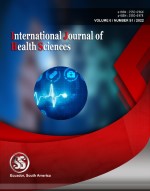Presenting a multi-objective method to maintain load balancing to reduce energy consumption using tabu search and frog leaping algorithms in cloud computing VMs
Keywords:
Cloud computing, Scheduling, Load balancing, Frog leapingAbstract
Cloud computing is considered one of the most important applied networks today. Many users around the world benefit from the services of this network. In this network, users first send their requests to cloud servers, and cloud servers then send the responses to these requests after processing them. In this process, the number of requests is much more than the number of servers; Therefore, it is necessary to perform a scheduling operation to ensure that the execution process is performed in the best possible way to reduce time and energy consumption. This research presents a multi-objective method to maintain load balancing to increase efficiency and reduce energy consumption by using tabu search and frog leaping algorithms in cloud computing VMs. This method consists of two parts: in the first part, the tasks are prioritized by the tabu search algorithm, and in the second part, the best machine is selected to be executed by the frog leaping algorithm. The simulation and comparison results indicate the acceptable performance of the proposed method.
Downloads
References
G, ¬¬lovasz, F, Nieedermeier, Hermann DE Meer, "Performance tradeoffs of energy-aware virtual machine Consolidation", 2012, DOI 10.1007/s10586, Page(s)481-496.
Beloglazov, Anton, Abawajy, Jemal, Buyy, Rajkumar," Energy-aware resource allocation heuristics for efficient management of data centers for Cloud computing", Elsevier Future Generation Computer Systems 28, 2012, Page(s)755-768.
Md. Shahjahan Kabir 1, Kh. Mohaimenul Kabir 2 and Dr. Rabiul Islam 3,PROCESS OF LOAD BALANCING IN CLOUD COMPUTING USING GENETIC ALGORITHM, Electrical & Computer Engineering: An International Journal (ECIJ) Volume 4, Number 2, June 2018
Amin Jula, Elankovan Sundararajan, Zalinda Othman, Expert Systems With Applications, Expert Systems With Applications 41 (2014) 3809–3824
Blau B., Neumann D., Weinhardt C., Lamparter S., "Palnning and Pricing Service Mashups", In proceeding of 10th IEEE conference on E-Commerce Technology and 5th IEEE conference on Enterprise Computing, pp.19-26, (2008).
https://www.linkedin.com/pulse/20140810144258-814120-choosing-the-best-way-to-move-virtual-machines
Chapin S.J., Katramatos D., Karpovich J., Grimshaw A.S., "The Legion Resource Management System", In Proc. of the 5th Workshop on Job Scheduling Strategies for Parallel Processing, in conjunction with the International Parallel and Distributed Processing Symposium, pp. 162-178, (1999).
Ullman JD., "NP-complete scheduling problems", In Journal of Computer and System sciences, pp. 384-393,(1975).
Workflow Management Coalition, Workflow Management Coalition Terminology & Glossary, (1999).
Guangshun Yao, "Endocrine-based coevolutionary multi-swarm for multi-objective workflow scheduling in a cloud system", Springer-Verlag Berlin Heidelberg 2018
Jung,Gihun, Mong Sim, Kwang, Location-Aware Dynamic Resource Allocation Model for Cloud Computing,Environment,in proceedings of International Conference on Information and Computer Applications,Dubai,2018. page 789-795
Xuan chen," Research of Improved Shuffled Frog Leaping Algorithmin Cloud Computing Resources, International Journal of Grid and Distributed ComputingVol. 9, No. 3 (2018)
Belousova NA, Korchemkina YV, Matuszak AF, Fortygina SN, Shulgina TA, Kovtun RF, Permyakova NE. Digital environment components for the formation of students’ information and analytical skills. Journal of Advanced Pharmacy Education & Research, 10(4), pp. 118-125. (2020)
El Ashiry EA, Alamoudi NM, Farsi NM, Al Tuwirqi AA, Attar MH, Alag HK, Basalim AA, Al Ashiry MK. The Use of Micro-Computed Tomography for Evaluation of Internal Adaptation of Dental Restorative Materials in Primary Molars: An In-Vitro Study. International Journal of Pharmaceutical Research & Allied Sciences, 8(1), pp. 129-137, (2019).
Published
How to Cite
Issue
Section
Copyright (c) 2022 International journal of health sciences

This work is licensed under a Creative Commons Attribution-NonCommercial-NoDerivatives 4.0 International License.
Articles published in the International Journal of Health Sciences (IJHS) are available under Creative Commons Attribution Non-Commercial No Derivatives Licence (CC BY-NC-ND 4.0). Authors retain copyright in their work and grant IJHS right of first publication under CC BY-NC-ND 4.0. Users have the right to read, download, copy, distribute, print, search, or link to the full texts of articles in this journal, and to use them for any other lawful purpose.
Articles published in IJHS can be copied, communicated and shared in their published form for non-commercial purposes provided full attribution is given to the author and the journal. Authors are able to enter into separate, additional contractual arrangements for the non-exclusive distribution of the journal's published version of the work (e.g., post it to an institutional repository or publish it in a book), with an acknowledgment of its initial publication in this journal.
This copyright notice applies to articles published in IJHS volumes 4 onwards. Please read about the copyright notices for previous volumes under Journal History.
















